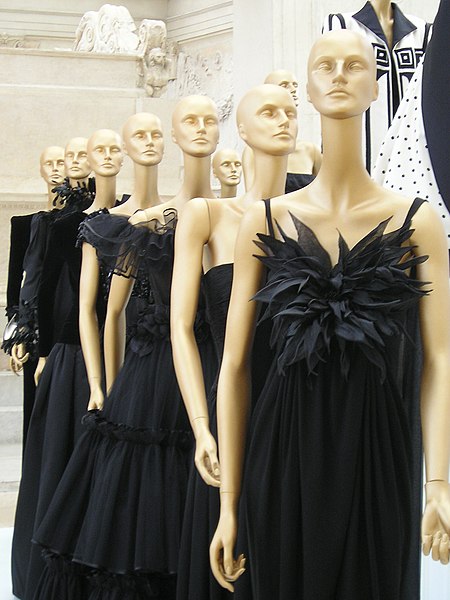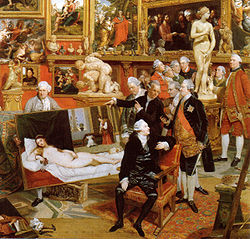
Italian fashion has amongst the world's most important fashion designs, such as those of France, USA, Great Britain and Japan. Fashion has always been an important part of the culture of Italy, and its society, and Italians are well known for their attention to dressing-up well, and "la bella figura", or good impression, remains traditional in the Italian way of living.
Italian designs began become one of Europe's main trendsetters eversince the 11th-16th centuries, when artistic development in Italy was at its peak. Cities such as Venice, Milan, Florence and Vicenza started to produce luxury goods, hats, cosmetics, jewelry and rich fabrics. During the 17th-early 20th centuries, Italian fashion lost its importance, and Europe's main trendsetter became France, as French fashion began to become hugely popular, eversince luxury dresses began to be designed for the courtiers of Louis XIV. However, since the 1951-53 fashion soirées held by Giovanni Battista Giorgini in Florence, the "Italian school" started to compete with the French haute couture, as labels such as Ferragamo and Gucci began to contend with Chanel and Dior. Currently, Milan, (Italy's center of design) is considered the true fashion capitalGlobal Language Monitor, and Rome ranked 4th. Both these cities annually compete with other major international centres, such as Paris, New York, LondonTokyo. of the world, according to the 2009 and
Examples of major Italian fashion houses are: Gucci, Armani, Emilio Pucci, Valentino, Prada, Dolce & Gabbana, Ferragamo, Roberto Cavalli, Trussardi, Versace, Krizia, Etro, Miu Miu, Laura Biagiotti, Max Mara, Fendi, Moschino, Missoni, Benetton and Brioni (fashion), to name a few. Italy also is home to many fashion magazines, such as Grazia, Vogue Italia, Vera, Chi, Gioia and Donna. Other Italian accessory and jewelry brands, such as Luxottica and Bulgari are amongst the most important in the world.
Fashion in Italy started to become the most fashionable in Europe since the 11th century, and powerful cities of the time, such as Venice, Milan, Florence, Vicenza and Rome began to produce robes, jewelry, textiles, shoes, fabrics, ornaments and elaborate dresses. Italian fashion reached its peak during the Renaissance. As Italy is widely recognized as the cradle and birthplace of the Renaissance, art, music, education, finance and philosophy flourished, and along with it, Italian fashion designs became immensly popular (especially those worn by the Medicis in Florence. The fashions of Queen Catherine de' Medici of France, were considered amongst the most fashionable in Europe).
After a decline in the 17th to mid-20th century, the nation returned to being a leading nation in fasjion, and Florence was Italy's fashion capital in the 50s and 60s, whilst Milan led the way in the 70s and 80s, with then-new labels, such as Versace, Armani and Dolce & Gabbana opening up and setting up their first boutiques and emporia. Until the 1970s, Italian fashion was mainly designed for rich and famous people, more or less like the French "Haute Couture". Yet, in the 1970s and 80s, Italian fashion started to concentrate on ready-to-wear clothes, such as jeans, jumpers and miniskirts. Milan became more affordable and stylish for shoppers, and Florence was deposed of its position as the Italian fashion capital. Today, Milan and Rome are Italy's fashion capitals, and are major international centres for fashion design, competing with other cities such as Tokyo, Los Angeles, London, Paris and New York. Also, other cities such as Venice, Florence, Naples, Vicenza, Bologna, Genoa and Turinshopping districts are the Via Montenapoleone fashion district and the Galleria Vittorio Emanuele (Milan), Via dei Condotti (Rome), and Via de' Tornabuoni (Florence).
Italy (pronounced /ˈɪtəli/ (The land known as Italy today has been the cradle of European cultures and peoples, such as the Etruscans and the Romans. Italy's capital, Rome, was for centuries the political centre of Western civilisation, as the capital of the Roman Empire. After its decline, Italy would endure numerous invasions by foreign peoples, from Germanic tribes such as the Lombards and Ostrogoths, to the Normans and later, the Byzantines, among others. Centuries later, Italy would become the birthplace of the Renaissance an immensely fruitful intellectual movement that would prove to be integral in shaping the subsequent course of European thought.
Through much of its post-Roman history, Italy was fragmented into numerous kingdoms and city-states (such as the Kingdom of Sardinia, the Kingdom of the Two Sicilies and the Duchy of Milan), but was unified in 1861, a tumultuous period in history known as the "Risorgimento". In the late 19th century, through World War I, and to World War II, Italy possessed a colonial empire, which extended its rule to Libya, Eritrea, Italian Somaliland, Ethiopia, Albania, Rhodes, the Dodecanese and a concession in Tianjin, China.[9]
Modern Italy is a democratic republic. It has been ranked the world's eighteenth most-developed country and its Quality-of-Life Index has been ranked in the top ten in the world. Italy enjoys a very high standard of living, and has a high nominal GDP per capita. It is a founding member of what is now the European Union and North Atlantic Treaty Organization. Italy is also a member of the G8 and G20. It has the world's seventh-largest nominal GDP, tenth highest GDP (PPP) and the fifth highest government budget in the world. It is also a member state of the Organisation for Economic Co-operation and Development, the World Trade Organization, the Council of Europe, and the Western European Union. Italy has the world's ninth-largest defence budget and shares NATO's nuclear weapons.
Foreign domination and Enlightenment (16th–19th centuries)
The holy alliance between Habsburg Spain and the Holy See resulted in the systematic persecution of any Protestant movement, with the result that Italy remained a Catholic country with marginal Protestant presence. During its long rule on Italy, the Spanish Empire systematically spoiled the country and imposed heavy taxation. It interfered and held a tight grip over the affairs of the Vatican. Moreover, Spanish administration was slow and inefficient, and its social consequences in the long term, in Southern Italy, where Spanish rule was effective, have lasted till the current age.
Austria succeeded Spain as hegemon in Italy after the Peace of Utrecht (1713), having acquired the State of Milan and the Kingdom of Naples. The Austrian domination, thanks to the Enlightenment embraced by Habsburgic emperors, somewhat improved the situation. The northern part of Italy, under the direct control of Vienna, gained economic dynamism and intellectual fervour. The main Italian cities, such as Milan, Rome, Turin, Venice, Florence and Naples became fertile grounds for intellectual discussion and thought, and several Italian philosophers and literary figures were active at the time, such as the Milanese Cesare, Marquis of Beccaria-Bonesana, better known as Cesare Beccaria, or Antonio Genovesi. Leopold I, Grand Duke of Tuscany or also known as Leopold II of the Holy Roman Empire, abolished the death penalty and torture in the Grand Duchy of Tuscany.
Italy in the 1700s was an important stop in the European Grand Tour, a period in which foreign, mostly British, aristocrats toured France, Italy and Greece to appreciate their arts and cultures, and their monuments. With the discovery of the classical ruins of Pompeii and Herculaneum in 1748, and the restoration of the derelict parts of the surviving ancient monuments in Rome, figures such as Goethe, Shelley, Keats and Byron toured the country. Cities such as Venice and Rome were the major attractions, and Naples, Florence, Turin, Sicily, and to some extent, Milan, were popular too. Keats famously said that "Italy is the paradise of exiles".
The French Revolution and the Napoleonic Wars (1796–1815) stirred the ideas of equality, democracy, law and nation which many in Italy endorsed and even supported as the basis on which they could and eventually would build national unity in Italy. This unity, or creation of modern Italy was yet to come in the second half of the nineteenth century (see Risorgimento and Italian Unification). The plague repeatedly returned to haunt Italy throughout the 14th to 17th centuries. Italy's last major epidemic occurred in 1656 in Naples. In northern Italy, a report of 1767 noted that there had been famine in 111 of the previous 316 years and only sixteen good harvests. Italy’s population between 1700 and 1800 rose by about one-third, to 18 million.



No comments:
Post a Comment